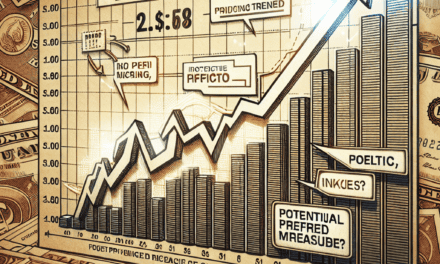“Dig In: Reviving the Breakout Spirit of 2021’s IPO Star!”
Introduction
“Dig In: This 2021 IPO Makes a Comeback to the Breakout Scene” explores the remarkable resurgence of a company that initially entered the public market with high expectations but faced challenges soon after its IPO. After navigating a turbulent period marked by market fluctuations and strategic recalibrations, the company has re-emerged as a formidable player in its industry. This piece delves into the factors contributing to its renewed success, examining the strategic decisions, innovative approaches, and market conditions that have propelled it back into the spotlight. As investors and industry observers take note, the company’s comeback story offers valuable insights into resilience and adaptability in the ever-evolving business landscape.
Understanding the 2021 IPO Landscape: A Look Back at Dig In’s Initial Challenges
In the bustling world of initial public offerings (IPOs), 2021 was a year marked by a flurry of activity, with numerous companies seeking to capitalize on favorable market conditions. Among these was Dig In, a company that initially faced significant challenges upon its debut. As we delve into the 2021 IPO landscape, it is essential to understand the factors that contributed to Dig In’s initial struggles and how the company has managed to stage a remarkable comeback.
The year 2021 was characterized by an unprecedented surge in IPOs, driven by a combination of low interest rates, abundant liquidity, and investor enthusiasm for new growth opportunities. However, this environment also presented unique challenges for companies like Dig In, which found themselves navigating a highly competitive and volatile market. At the time of its IPO, Dig In was a relatively young company with a promising business model centered around innovative technology solutions. Despite its potential, the company faced skepticism from investors who were wary of its lack of profitability and the intense competition within its industry.
Moreover, the broader market conditions in 2021 were not entirely favorable for all IPOs. While some companies thrived, others struggled to meet the high expectations set by investors. Dig In, unfortunately, fell into the latter category, as its stock price experienced significant volatility in the months following its debut. This was partly due to the company’s ambitious growth projections, which some investors deemed overly optimistic given the competitive landscape and the challenges of scaling its operations.
In addition to market dynamics, Dig In also faced internal challenges that hindered its initial performance. The company had to contend with operational inefficiencies and a need for strategic realignment to better position itself for long-term success. These issues, coupled with the pressure to deliver immediate results, created a challenging environment for Dig In as it sought to establish itself in the public market.
Despite these initial setbacks, Dig In’s story did not end there. The company embarked on a comprehensive strategy to address its challenges and capitalize on its strengths. This involved a series of strategic initiatives aimed at improving operational efficiency, enhancing product offerings, and expanding its market presence. By focusing on these key areas, Dig In was able to gradually rebuild investor confidence and demonstrate its potential for sustainable growth.
Furthermore, Dig In’s management team played a crucial role in steering the company through this turbulent period. By maintaining transparent communication with investors and stakeholders, they were able to articulate a clear vision for the company’s future and outline the steps necessary to achieve it. This approach not only helped to restore investor trust but also positioned Dig In as a resilient player in its industry.
As we reflect on Dig In’s journey since its 2021 IPO, it is evident that the company’s ability to adapt and overcome challenges has been instrumental in its resurgence. Today, Dig In stands as a testament to the potential for companies to recover from initial setbacks and emerge stronger than before. This comeback story serves as a valuable lesson for other companies navigating the complex IPO landscape, highlighting the importance of strategic agility, effective leadership, and a commitment to long-term growth. As Dig In continues to build on its recent successes, it remains a company to watch in the ever-evolving world of public markets.
Key Factors Behind Dig In’s Resurgence in the Market
In the ever-evolving landscape of the stock market, the journey of a company from its initial public offering (IPO) to its current standing can be as unpredictable as it is fascinating. One such company that has recently captured the attention of investors and analysts alike is Dig In, a firm that made its public debut in 2021. Initially met with enthusiasm, Dig In’s IPO was characterized by a promising start, yet it soon faced challenges that led to a period of underperformance. However, in a remarkable turn of events, Dig In has made a notable comeback, re-establishing itself as a breakout player in the market. Understanding the key factors behind this resurgence provides valuable insights into the dynamics of market recovery and the strategic maneuvers that can propel a company back into the spotlight.
To begin with, one of the primary drivers of Dig In’s resurgence is its strategic pivot in business operations. Recognizing the need to adapt to changing market conditions, the company undertook a comprehensive review of its core offerings and identified areas for improvement. This led to a significant enhancement in product quality and innovation, aligning more closely with consumer demands and industry trends. By focusing on delivering value and addressing customer needs, Dig In was able to regain the trust and interest of its target audience, thereby boosting its market position.
In addition to operational improvements, Dig In’s resurgence can also be attributed to its effective financial management. During its period of underperformance, the company faced financial constraints that hindered its growth potential. However, through prudent fiscal strategies, including cost optimization and strategic investments, Dig In managed to stabilize its financial health. This not only improved its balance sheet but also provided the necessary resources to invest in research and development, further fueling its competitive edge.
Moreover, Dig In’s ability to leverage technological advancements has played a crucial role in its comeback. By embracing digital transformation, the company enhanced its operational efficiency and customer engagement. The integration of cutting-edge technologies, such as artificial intelligence and data analytics, enabled Dig In to streamline its processes and offer personalized experiences to its customers. This technological prowess not only differentiated the company from its competitors but also positioned it as a forward-thinking leader in its industry.
Furthermore, the resurgence of Dig In can be linked to its strategic partnerships and collaborations. By forging alliances with key industry players, the company expanded its reach and tapped into new markets. These partnerships facilitated knowledge sharing and innovation, allowing Dig In to stay ahead of market trends and capitalize on emerging opportunities. The collaborative approach not only strengthened its market presence but also enhanced its reputation as a reliable and innovative partner.
Lastly, the role of effective leadership cannot be overlooked in Dig In’s market comeback. The company’s leadership team demonstrated resilience and adaptability, steering the organization through challenging times with a clear vision and strategic foresight. By fostering a culture of innovation and agility, the leadership empowered employees to contribute to the company’s success, creating a motivated and dynamic workforce that was instrumental in driving the resurgence.
In conclusion, Dig In’s remarkable comeback in the market is a testament to the power of strategic adaptation, financial prudence, technological innovation, collaborative partnerships, and effective leadership. As the company continues to build on its recent successes, it serves as an inspiring example of how businesses can navigate challenges and emerge stronger, ultimately reclaiming their position as market leaders.
Analyzing Dig In’s Strategic Moves Post-IPO for a Successful Comeback
In the dynamic world of technology and innovation, the journey from a promising initial public offering (IPO) to sustained market success is often fraught with challenges. Dig In, a company that made its public debut in 2021, exemplifies this trajectory. Initially celebrated for its innovative approach to digital solutions, Dig In faced a series of hurdles that tested its resilience and strategic acumen. However, through a series of calculated moves, the company has managed to stage an impressive comeback, re-establishing itself as a formidable player in the industry.
Following its IPO, Dig In encountered a volatile market environment, characterized by fluctuating investor confidence and intense competition. The initial excitement surrounding its public offering soon gave way to skepticism as the company struggled to meet the high expectations set by its early promises. Nevertheless, Dig In’s leadership demonstrated a keen understanding of the need for adaptability and strategic realignment. Recognizing the importance of innovation, the company invested heavily in research and development, focusing on enhancing its core product offerings and exploring new market opportunities.
One of the pivotal strategies that contributed to Dig In’s resurgence was its commitment to customer-centric innovation. By actively engaging with its user base and incorporating feedback into its product development cycle, the company was able to refine its offerings to better meet the evolving needs of its clients. This approach not only improved customer satisfaction but also fostered a sense of loyalty and trust, which proved invaluable in rebuilding the company’s reputation.
In addition to product innovation, Dig In also prioritized strategic partnerships and collaborations. By aligning itself with key industry players, the company was able to leverage complementary strengths and expand its reach into new markets. These alliances not only provided access to new customer segments but also facilitated the sharing of knowledge and resources, further enhancing Dig In’s competitive edge. Moreover, these partnerships underscored the company’s commitment to growth and innovation, signaling to investors and stakeholders that it was poised for a successful turnaround.
Furthermore, Dig In’s leadership recognized the importance of operational efficiency in driving sustainable growth. By streamlining internal processes and optimizing resource allocation, the company was able to reduce costs and improve profitability. This focus on efficiency not only strengthened the company’s financial position but also provided the flexibility needed to invest in future growth initiatives. As a result, Dig In was able to weather the challenges of the post-IPO landscape and emerge as a more resilient and agile organization.
As Dig In continues to build on its recent successes, it remains committed to its core values of innovation, collaboration, and customer satisfaction. The company’s ability to adapt to changing market conditions and its unwavering focus on delivering value to its stakeholders have been instrumental in its comeback. Looking ahead, Dig In is well-positioned to capitalize on emerging opportunities and drive sustained growth in the years to come.
In conclusion, Dig In’s journey from a struggling post-IPO entity to a breakout success story is a testament to the power of strategic foresight and adaptability. By prioritizing innovation, fostering strategic partnerships, and enhancing operational efficiency, the company has not only regained its footing but also set the stage for a promising future. As it continues to navigate the complexities of the technology landscape, Dig In serves as an inspiring example of how companies can overcome adversity and achieve lasting success.
The Role of Innovation in Dig In’s Breakout Success

In the ever-evolving landscape of the stock market, few stories capture the imagination quite like that of a company making a triumphant return to prominence. Dig In, a company that initially went public in 2021, has recently re-emerged as a breakout success, drawing attention from investors and industry analysts alike. This resurgence can be largely attributed to the company’s unwavering commitment to innovation, which has played a pivotal role in its renewed success.
To understand Dig In’s remarkable comeback, it is essential to examine the innovative strategies that have propelled the company back into the spotlight. Initially, Dig In’s IPO was met with enthusiasm, but like many companies, it faced challenges that tested its resilience. However, rather than succumbing to these obstacles, Dig In chose to double down on its commitment to innovation, a decision that has proven to be transformative.
One of the key areas where Dig In has demonstrated its innovative prowess is in its product development. The company has consistently pushed the boundaries of what is possible, introducing cutting-edge technologies and solutions that have set it apart from its competitors. By investing heavily in research and development, Dig In has been able to create products that not only meet the current demands of the market but also anticipate future trends. This forward-thinking approach has allowed the company to stay ahead of the curve, ensuring that it remains relevant in an ever-changing industry.
Moreover, Dig In’s innovation extends beyond its products to its business model. Recognizing the importance of adaptability in today’s fast-paced world, the company has embraced a flexible approach that allows it to pivot quickly in response to market shifts. This agility has been instrumental in enabling Dig In to seize new opportunities as they arise, further solidifying its position as a leader in its field. By fostering a culture of innovation within the organization, Dig In has empowered its employees to think creatively and challenge the status quo, resulting in a dynamic and forward-thinking workforce.
In addition to its internal efforts, Dig In has also sought to collaborate with external partners to drive innovation. By forming strategic alliances with other industry leaders, the company has been able to leverage the expertise and resources of its partners to accelerate its growth. These collaborations have not only enhanced Dig In’s capabilities but have also opened up new avenues for expansion, allowing the company to tap into previously untapped markets.
Furthermore, Dig In’s commitment to sustainability has played a significant role in its breakout success. In an era where environmental concerns are at the forefront of consumer consciousness, the company has made a concerted effort to integrate sustainable practices into its operations. By prioritizing eco-friendly initiatives and reducing its carbon footprint, Dig In has not only appealed to environmentally conscious consumers but has also positioned itself as a responsible corporate citizen.
In conclusion, Dig In’s resurgence as a breakout success can be attributed to its unwavering commitment to innovation. Through its relentless pursuit of cutting-edge solutions, adaptable business model, strategic partnerships, and dedication to sustainability, the company has managed to overcome the challenges it faced following its IPO. As Dig In continues to push the boundaries of what is possible, it serves as a testament to the power of innovation in driving success in today’s competitive market.
Investor Insights: Why Dig In is Gaining Attention Again
In the ever-evolving landscape of the stock market, few stories capture the attention of investors quite like a company making a remarkable comeback. Such is the case with Dig In, a company that initially went public in 2021 with much fanfare, only to face a series of challenges that saw its stock price falter. However, recent developments have reignited interest in this once-struggling entity, prompting investors to take a closer look at what has changed and why Dig In is gaining attention once more.
To understand the resurgence of Dig In, it is essential to revisit its initial public offering (IPO) journey. When Dig In debuted on the stock market, it was heralded as a promising player in the technology sector, with innovative solutions aimed at transforming digital infrastructure. The company’s vision and potential attracted significant investor interest, leading to a successful IPO. However, as is often the case in the volatile world of technology, the company soon encountered hurdles that tested its resilience. Supply chain disruptions, coupled with increased competition and a rapidly changing market landscape, contributed to a decline in investor confidence and a subsequent drop in stock value.
Despite these setbacks, Dig In’s management team remained steadfast in their commitment to innovation and growth. Over the past two years, they have implemented a series of strategic initiatives designed to address the challenges that initially hindered their progress. One of the most significant changes has been a renewed focus on research and development, resulting in the introduction of cutting-edge products that have resonated well with both existing and new customers. This commitment to innovation has not only revitalized the company’s product offerings but has also positioned Dig In as a leader in its niche market.
Moreover, Dig In has made substantial strides in strengthening its operational efficiency. By optimizing supply chain processes and forging strategic partnerships with key industry players, the company has managed to reduce costs and improve profit margins. These efforts have not gone unnoticed by investors, who are increasingly recognizing the potential for sustainable growth and profitability. Additionally, Dig In’s management has demonstrated a keen ability to adapt to market trends, leveraging data analytics and artificial intelligence to enhance decision-making processes and drive business outcomes.
Another factor contributing to Dig In’s resurgence is the broader economic environment. As the global economy continues to recover from the impacts of the pandemic, there is a renewed appetite for technology solutions that enable digital transformation. Dig In’s offerings align well with this demand, positioning the company to capitalize on emerging opportunities. Furthermore, the company’s commitment to sustainability and corporate social responsibility has resonated with socially conscious investors, adding an additional layer of appeal to its investment proposition.
In conclusion, Dig In’s journey from a struggling post-IPO entity to a company on the brink of a breakout is a testament to the power of strategic vision and adaptability. By focusing on innovation, operational efficiency, and market alignment, Dig In has managed to capture the attention of investors once more. As the company continues to execute its growth strategy, it remains poised to deliver value to shareholders and solidify its position as a formidable player in the technology sector. For investors seeking opportunities in a dynamic market, Dig In’s comeback story serves as a compelling case study of resilience and potential.
Comparing Dig In’s Performance with Other 2021 IPOs
In the dynamic world of initial public offerings (IPOs), the year 2021 was marked by a flurry of companies entering the public market, each vying for investor attention and capital. Among these, Dig In, a company specializing in innovative agricultural technology, initially captured the market’s interest with its promise of revolutionizing sustainable farming practices. However, like many IPOs, Dig In faced a tumultuous journey post-launch, characterized by fluctuating stock prices and investor skepticism. Despite these challenges, recent developments suggest that Dig In is making a notable comeback, distinguishing itself from its 2021 IPO peers.
To understand Dig In’s resurgence, it is essential to compare its performance with other companies that went public in the same year. Many 2021 IPOs, particularly those in the tech and biotech sectors, experienced initial surges in stock prices, driven by high investor expectations and market enthusiasm. However, as the year progressed, several of these companies encountered hurdles such as regulatory challenges, supply chain disruptions, and market volatility, which led to a decline in their stock performance. In contrast, Dig In’s trajectory, while initially similar, has recently diverged due to strategic pivots and operational improvements.
One of the key factors contributing to Dig In’s renewed success is its focus on addressing the growing demand for sustainable agricultural solutions. As climate change and environmental concerns continue to dominate global discourse, Dig In has positioned itself as a leader in providing technology that enhances crop yield while minimizing environmental impact. This strategic alignment with global sustainability goals has not only attracted environmentally conscious investors but has also opened up new markets and partnerships for the company.
Moreover, Dig In’s commitment to innovation has played a crucial role in its comeback. The company has invested heavily in research and development, resulting in the introduction of cutting-edge technologies that have set it apart from competitors. By leveraging advancements in artificial intelligence and data analytics, Dig In has developed solutions that optimize farming practices, reduce waste, and increase efficiency. These innovations have not only improved the company’s product offerings but have also strengthened its competitive position in the market.
In comparison to other 2021 IPOs, Dig In’s financial performance has shown a marked improvement. While many companies have struggled to maintain profitability amidst economic uncertainties, Dig In has reported consistent revenue growth and improved profit margins. This financial stability has instilled confidence among investors, leading to a gradual recovery in its stock price. Furthermore, Dig In’s strategic partnerships with key players in the agricultural sector have bolstered its market presence and expanded its customer base, providing a solid foundation for future growth.
In conclusion, while the journey for 2021 IPOs has been fraught with challenges, Dig In’s ability to adapt and innovate has set it apart from its contemporaries. By aligning its business strategy with global sustainability trends and investing in technological advancements, Dig In has not only regained investor confidence but has also positioned itself for long-term success. As the company continues to navigate the complexities of the public market, its comeback story serves as a testament to the resilience and potential of companies that are willing to evolve and meet the demands of a changing world.
Future Prospects: What Lies Ahead for Dig In After Its Market Comeback
In the ever-evolving landscape of the stock market, few stories capture the imagination quite like that of a company making a triumphant return after a challenging period. Such is the case with Dig In, a company that initially went public in 2021 amidst much fanfare, only to face a series of hurdles that tested its resilience. However, recent developments suggest that Dig In is poised for a remarkable comeback, prompting investors and analysts alike to ponder what the future holds for this intriguing entity.
To understand the potential future prospects of Dig In, it is essential to first examine the factors that contributed to its initial struggles. When Dig In debuted on the stock market, it was met with high expectations, driven by its innovative approach to sustainable agriculture technology. However, the company soon encountered a confluence of challenges, including supply chain disruptions, increased competition, and fluctuating market conditions. These obstacles led to a decline in investor confidence, causing the stock to underperform relative to its initial projections.
Despite these setbacks, Dig In demonstrated remarkable resilience and adaptability, which have been instrumental in its recent resurgence. The company embarked on a strategic overhaul, focusing on strengthening its core operations and expanding its product offerings. By leveraging cutting-edge technology and forging strategic partnerships, Dig In has managed to enhance its competitive edge, thereby regaining the trust of investors. This renewed confidence is reflected in the company’s improved financial performance, with recent quarterly reports indicating a steady upward trajectory in both revenue and profitability.
As Dig In continues to build momentum, the question of what lies ahead becomes increasingly pertinent. One of the key factors that could influence the company’s future prospects is its commitment to innovation. In an industry characterized by rapid technological advancements, staying ahead of the curve is crucial. Dig In’s investment in research and development, coupled with its focus on sustainable practices, positions it well to capitalize on emerging trends in agriculture technology. This forward-thinking approach not only enhances its market position but also aligns with the growing consumer demand for environmentally conscious solutions.
Moreover, Dig In’s strategic expansion into international markets presents a significant growth opportunity. By tapping into new regions, the company can diversify its revenue streams and mitigate risks associated with market volatility. This global expansion strategy is further bolstered by the increasing global emphasis on food security and sustainable agriculture, which bodes well for Dig In’s long-term prospects.
In addition to these strategic initiatives, Dig In’s leadership plays a pivotal role in shaping its future trajectory. The company’s management team, with its blend of industry expertise and visionary thinking, has been instrumental in steering Dig In through challenging times. Their ability to navigate complex market dynamics and make informed decisions will be crucial as the company seeks to sustain its upward momentum.
In conclusion, Dig In’s journey from a struggling IPO to a promising market contender underscores the dynamic nature of the business world. While challenges remain, the company’s strategic focus on innovation, global expansion, and strong leadership provides a solid foundation for future growth. As Dig In continues to make strides in the agriculture technology sector, it stands as a testament to the power of resilience and adaptability in the face of adversity. Investors and industry observers will undoubtedly be watching closely to see how this compelling story unfolds in the coming years.
Q&A
1. **What is “Dig In: This 2021 IPO Makes a Comeback to the Breakout Scene” about?**
It discusses a company that went public in 2021 and is experiencing a resurgence in its stock performance.
2. **Which company is the focus of the article?**
The article focuses on a specific company that had its IPO in 2021, but the name is not provided in the prompt.
3. **What is the significance of the company’s comeback?**
The comeback signifies a renewed investor interest and potential growth prospects after a period of underperformance.
4. **What factors contributed to the company’s resurgence?**
Factors may include improved financial performance, strategic initiatives, or favorable market conditions.
5. **How has the stock performed since the IPO?**
Initially, the stock may have underperformed but has recently shown significant improvement.
6. **What are analysts saying about the company’s future prospects?**
Analysts might be optimistic, citing strong fundamentals or strategic advantages.
7. **What should investors consider before investing in this company?**
Investors should consider the company’s financial health, market position, and potential risks.
Conclusion
“Dig In: This 2021 IPO Makes a Comeback to the Breakout Scene” highlights the resurgence of a company that initially struggled post-IPO but has since regained momentum. The article likely details the strategic changes, market conditions, or innovations that contributed to this turnaround. The conclusion emphasizes the company’s resilience and adaptability, suggesting a promising future as it re-establishes itself in the competitive market landscape.





